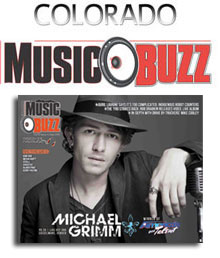The Manager’s Corner- August
by Chris Daniels
I’ve managed my own band for 31 years and I’m in the Colorado Music Hall of Fame. All that’s nice but today’s music business is changing at light-speed and you have to be more engaged in the ‘biz’ than ever. Some things have not changed, careers are built on some tried and true elements: great music, performance and timing. But today’s artists must work harder than ever to succeed. The good news is that we have new tools to help young musicians grow their fan base. The book I wrote for the course I teach at CU Denver on artist management is called “DIY: You’re Not in it Alone.” While you are ultimately responsible for your own career, these days it’s essential to make the most of all the outlets that are offered along the way.
We are just over halfway through the year (amazing) and it looks like there are some interesting trends hitting various sectors of our music business marketplace. The first and most telling is that streaming is taking over and vinyl is gaining strength. Most of you know this and are already using some form of streaming in your daily music consumption. But here are some things you may not know. (1) Tidal looks like it is dead in the water, which is too bad because they paid artists the best (about a penny and a half per stream). (2) ITunes’ streaming service screwed up their interface so badly that iTunes Music Streaming may actually not survive. In addition, Digital Music News reported that they are now messing with the Spotify app distributed in Apple’s app store. Spotify’s subscription model is increasing in membership but it is still not financially viable. Despite these issues, some astonishing facts and figures were released this month in Pollstar, Billboard, Digital Music News and others. They all indicate shifts in the record business – “a disturbance in the force.”
Most important for DIY artists is the fact that video streaming (YouTube) is up 109% over last year and audio streaming is up almost 75%. Streaming is, for better or worse, where we are going. That means that revenue for the DIY artist from the “sale” of recordings via streaming will increase in pennies (about half a cent for every stream on Spotify) while the sale of digital downloads and physical, (iTunes/Amazon and CD) will decrease in dollars. iTunes pays about $6.40 to a DIY artist for a 10-song album. If a fan buys a CD at the merch booth or even at Twist & Shout, the artist nets about $9.00. Streaming albums are measured as SEA (1,500 streams equals one album download). If that same fan streams a song on Spotify 1,500 times – the DIY artist would make about $5.50. And if that same fan streamed it on iTunes, the DIY artist would get a whopping $2.20. YouTube is worse – but that is due to how views are calculated and whether it is a repeat view and whether there are advertisements on the video and whether the DIY artist is tapped into that revenue stream.
Vinyl, as discussed many times in these articles, is coming on strong. Sale of LPs are up 38%. But there are some things to consider. It still only makes up less than 5% of the total revenue spent on recorded music – and we are starting to get solid data on who’s buying it…in short, young fans, particularly of hip-hop and EDM. Last but not least on the sale of recorded music, CD sales are only down 4 percent and still make up almost half of the revenue for sale of all recorded music – roughly 48%, especially at touring artist’s merch booths.
What is the take away? DIY artists who make records should look for other funding because record sales from streaming won’t recoup the studio, pressing and marketing expenses. This is one of the many reasons why major labels are pushing 360 deals on their new artists. The big three simply cannot recoup on sale of recordings. It is also why labels are even more reluctant to “develop” an act over time like they did with Springsteen and many others from that golden era of the record business. There is no incentive or ability to cover years of loss in hopes of a big payoff. Catalogue and sale of repackaged “evergreens” are now the backbone of the major label economy – along with the one or two annual break out singles that keep a label afloat – songs like “Uptown Funk” 6.4 million actual downloads. So far, Taylor Swift is the only “million selling” album this year, though she is likely to be joined by others at year’s end.
That brings us to the concert business. It has not succumbed to digital destruction like the record business despite some very innovative internet concert events. Live music is the oldest and now, most lucrative revenue stream for artists – provided they can get to a level where they are paid a living wage. This summer we’ve seen some remarkable “events” like the Grateful Dead’s farewell concerts in Chicago (we’ll see if that really was their last). The Stones and U2 didn’t have to drop their prices despite troubles early on in tickets sales. For artists like the Stones it took some pretty sophisticated manipulation to maintain their $178 average price but they succeeded. The overall major tour industry average ticket price hit $76.20 (up about $4 from last year’s high – before “service” fees). There were plenty of seats that went for less. Red Rocks will see promoters like AEG and Live Nation present more than 120 shows this season…the most ever. And that is only one part of the major Colorado tour market. Fiddler’s Green (operated by AEG) and The 1stBank Center (also operated by AEG) are doing more than 30 shows this summer and fall. Others like the Pepsi Center, The Budweiser Events Center, Dick’s Sporting Goods Park and even Sports Authority Field are doing major concert events. Add to this the major festivals like Telluride Bluegrass and the traveling festivals like Riot Fest and Warped Tour and you have more major shows than one market can accommodate – unless that market is Colorado.
The top 100 grossing tours pulled in $1.34 billion so far this year, up $402 million over this time last year. The concert industry is still in the “sweet-spot” with ”demand,” pricing and ticket sales – meaning that even though fans may complain about the prices – if they really want to see a show – they will find a way to get tickets. Aging artists, who can bring in major crowds, are doing well – as are a growing number of young artists with a good business sense and survival skills. Taylor Swift, Bruno Mars, Drake and others are business savvy and tough as nails – making the hundreds of millions that was once the domain of the old farts.
What it means for the DIY artist is a little harder to quantify but there is some clear information coming in. Venues like the Bluebird, Ogden and Fillmore are part of a growing circuit of 300 to 3,500 seat rooms that include House of Blues, the 930 Club in Washington D.C. and the Fox in Boulder. There are over 200 US venues that are presenting acts like Johnnyswim and Lake Street Dive and a new generation of artists who can pack these rooms on a Sunday or Thursday night using sophisticated internet marketing. These rooms are paying headliners anywhere from $5,000 to $25,000 and up. That means that a touring act doing 150 dates a year is making a good living – if they keep their expenses down and the merch stocked. The numbers are pretty strong. If you can sell out the Gothic with a $5,000 guarantee vs. 80% of the door after expenses – and you can do that in 150 markets and venues – your gross is about $750,000 a year before management, road and agent expenses. Assuming you are a 5-piece band and you can net around half-a-million, your potential is $90,000 each before taxes. That is better than a standard “middle-class” wage – but is hard work and takes a toll on families and player’s lives. That figure doesn’t include merch or, as I have preached many times in this column, publishing money. You should be working with your “performing rights organization,” registering your songs and performances with ASCAP, BMI or SESAC. Publishing should bring in money above and beyond performance royalties but also placement revenue.
Last and truly not least in this mid-year review are the “innovators” in the industry. I’m not talking about Pono and some of the unsupported “vanity” efforts of “stars.” Like Donald Trump, a lot of these folks have a weird factor that gets them plenty of media coverage but in the long run they add little value to the musician or music fan. Services like Tidal that got a huge star-studded rollout contained basic design flaws that seem to spell their doom almost from the get-go. No, what I’m writing about are the ones that ARE changing the music industry. Things like Ticketfly and Pledge Music. There are about 20 companies and innovators that are currently reshaping the music business, as we know it. Next Big Sound, which got its start in Boulder in 2008 and moved to NYC in 2012 is probably one of the most exciting. For those of you who are not familiar with what they do, NBS is a data analytic company that tracks your internet presences and how effectively you are reaching your fans. They have an introductory level that is free and it is actually pretty helpful. They also have advanced levels for artists with a more national or global reach. They track all of your internet interfaces (YouTube, website etc) and once you get past the free level you can really drill down into the analytical information to come up with better strategies for marketing your “brand.” If that all sounds foreign to you, like it has nothing to do with your rockin’ show at the Larimer Lounge last night – you need to understand that the headliner at that show was not from Colorado – that they packed that room by using the internet – and that they were selling a “brand.” If you want to take that one step farther, ask yourself how you are going to fill The Village Underground in New York or The Fineline in Minneapolis where nobody knows who you are, where radio is not interested in playing your record and where you have never played before. Answer, lots of data.
Category: Shop Talk






